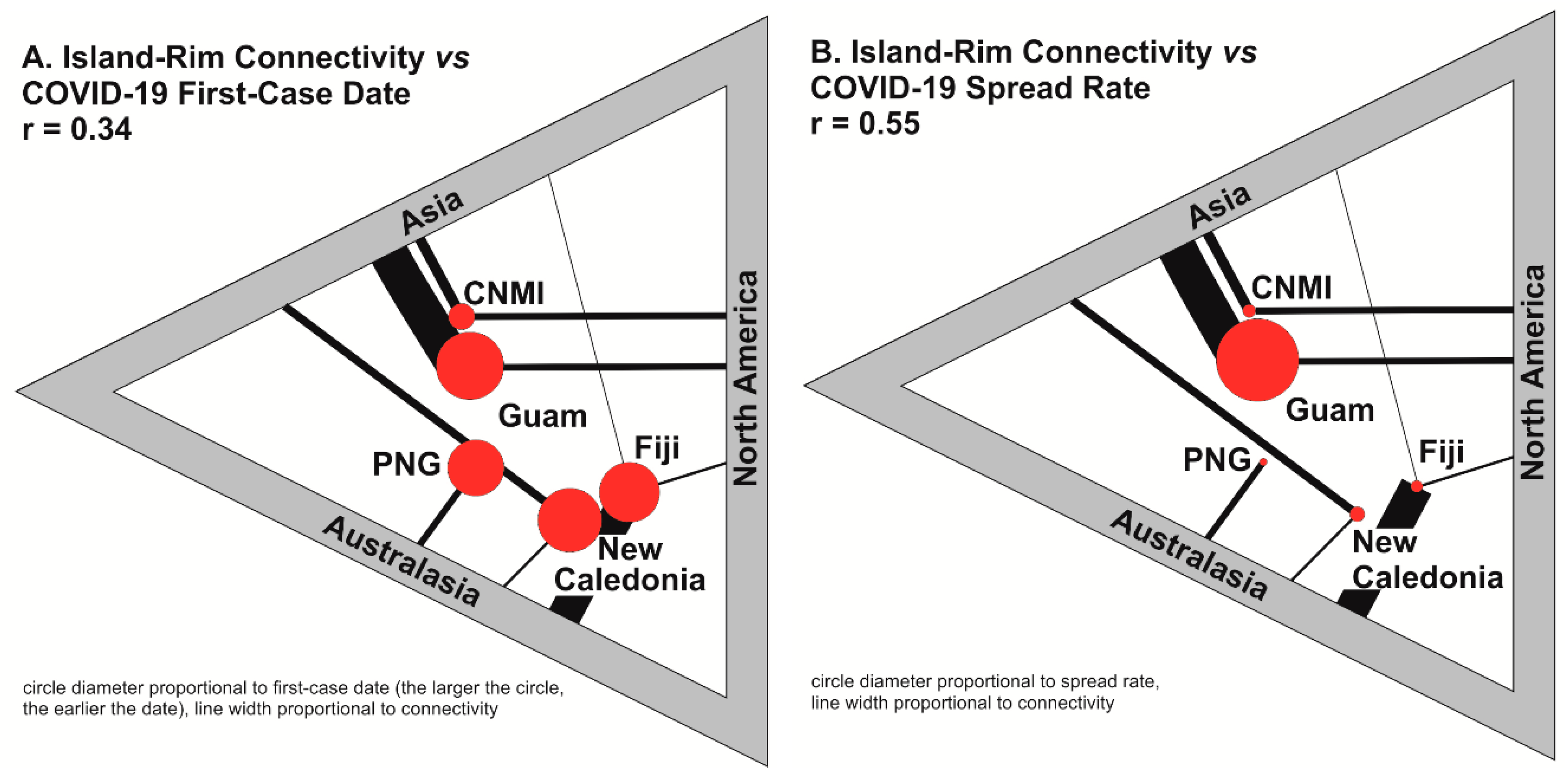Coronavirus: COVID-19 Transmission in Pacific Small Island Developing States
Abstract
1. Introduction
2. Methods
3. Results
4. Discussion
Reducing Connectivity: Socio-Economic Implications
5. Conclusions
- Addressing how to mitigate social and economic impacts of the outbreak response related to health systems;
- Identifying non-intended consequences of epidemic control decisions;
- Providing answers to social dynamics of the outbreak and the related public health response;
- Identifying the means to address inequalities that may be exacerbated by the epidemic, such as limited access to medical services and treatments, especially among the elderly.
Author Contributions
Funding
Conflicts of Interest
References
- WHO. Coronavirus Disease 2019 (COVID-19) Situation Report—51. Available online: https://www.who.int/docs/default-source/coronaviruse/situation-reports/20200311-sitrep-51-covid-19.pdf?sfvrsn=1ba62e57_10 (accessed on 20 April 2020).
- WHO. Coronavirus Disease 2019 (COVID-19) Situation Report—52. Available online: https://www.who.int/docs/default-source/coronaviruse/situation-.reports/20200312-sitrep-52-covid-19.pdf?sfvrsn=e2bfc9c0_4 (accessed on 20 April 2020).
- WHO. Coronavirus Disease 2019 (COVID-19) Situation Report—56. Available online: www.who.int/docs/default-source/coronaviruse/situation-reports/20200316-sitrep-56-covid-19.pdf?sfvrsn=9fda7db2_6 (accessed on 20 April 2020).
- WHO. Coronavirus Disease 2019 (COVID-19) Situation Report—77. Available online: https://www.who.int/docs/default-source/coronaviruse/situation-reports/20200406-sitrep-77-covid-19.pdf?sfvrsn=21d1e632_2 (accessed on 20 April 2020).
- Craig, A.; Heywood, A.; Hall, J. Risk of COVID-19 importation to the Pacific islands through global air travel. Epidem. Infec. 2020, 1–16. [Google Scholar] [CrossRef] [PubMed]
- Vandhana, N. Pacific Islands Forum Foreign Ministers Agree to Establish a Pacific Humanitarian Pathway on COVID-19. Available online: https://www.forumsec.org/pacific-islands-forum-foreign-ministers-agree-to-establish-a-pacific-humanitarian-pathway-on-covid-19/?fbclid=IwAR3P9kElpaoutHqt-Jf7xnJOwAneHo4xINzsUUXuAnZR-WNJEdVNORzKX_k (accessed on 28 April 2020).
- WHO. Pacific Steps Up Preparedness Against COVID-19. 2020. Available online: https://www.who.int/westernpacific/about/how-we-work/pacific-support/news/detail/21-02-2020-pacific-steps-up-preparedness-against-covid-19 (accessed on 20 April 2020).
- Johns Hopkins University. Center for Systems Science and Engineering (CSSE) GitHub Repository. Available online: https://github.com/CSSEGISandDATA/COVID-19 (accessed on 17 April 2020).
- John Hopkins University. COVID Dashboard. Available online: https://www.arcgis.com/apps/opsdashboard (accessed on 17 April 2020).
- World Health Organization. COVID-19 Tracker. Available online: https://who.sprinklr.com (accessed on 14 April 2020).
- Dong, E.; Du, H.; Gardner, L. An interactive web-based dashboard to track COVID-19 in real time. Lancet 2020. [Google Scholar] [CrossRef]
- Luetz, J.M.; Havea, P.H. “We’re not refugees, We’ll stay here until we die!”—Climate change adaptation and migration experiences gathered from the Tulun and Nissan Atolls of Bougainville, Papua New Guinea. In Climate Change Impacts and Adaptation Strategies for Coastal Communities; Leal Filho, W., Ed.; Springer Nature: Cham, Switzerland, 2018; pp. 3–29. [Google Scholar] [CrossRef]
- U.S. Embassy in Fiji, Kiribati, Nauru, Tonga, and Tuvalu. COVID-19 Information. 2020. Available online: https://fj.usembassy.gov/u-s-citizen-services/covid-19-information (accessed on 30 April 2020).
- Mayo Clinic. COVID-19: How Much Protection Do Face Masks Offer? 2020. Available online: https://www.mayoclinic.org/diseases-conditions/coronavirus/in-depth/coronavirus-mask/art-20485449 (accessed on 30 April 2020).
- Wainiqolo, I.; Shivanjali, S. Modelling Fiji’s Tourism Arrivals. Available online: https://www.rbf.gov.fj/getattachment/Publications/Working-Paper-Modelling-Fiji’s-Tourism-Arrivals/Modelling-Fiji-s-Tourism-Arrivals.pdf (accessed on 30 April 2020).
- Asian Development Bank. Asian Development Outlook. Available online: https://www.adb.org/sites/default/files/publication/575626/ado2020.pdf (accessed on 29 April 2020).
- World Bank. East Asia and Pacific: Countries must Act Now to Mitigate Economic Shock of COVID-19. Available online: https://www.worldbank.org/en/news/press-release/2020/03/30/east-asia-and-pacific-countries-must-act-now-to-mitigate-economic-shock-of-covid-19 (accessed on 27 April 2020).
- Sattler, D.N.; Lousi, U.; Graham, J.M.; Latu, V.; Johnson, J.; Helu, S.L. Climate Change in Tonga: Risk Perception and Behavioral Adaptation. In Managing Climate Change Adaptation in the Pacific Region. Climate Change Management; Leal Filho, W., Ed.; Springer: Cham, Switzerland, 2020. [Google Scholar] [CrossRef]
- Patricola, C.; Wehner, M. Anthropogenic influences on major tropical cyclone events. Nature 2018, 563, 339–346. [Google Scholar] [CrossRef] [PubMed]
- Saumweber, W.; Lehr, A.; Loft, T.; Kim, S. Covid-19 at Sea: Impacts on the Blue Economy, Ocean Health, and Ocean Security. Available online: https://www.csis.org/analysis/covid-19-sea-impacts-blue-economy-ocean-health-and-ocean-security (accessed on 30 April 2020).
- Anastassopoulou, C.; Russo, L.; Tsakris, A.; Siettos, C. Data-based analysis, modelling and forecasting of the COVID-19 outbreak. PLoS ONE 2020, 15. [Google Scholar] [CrossRef] [PubMed]
- Myers, A.; Kent, J. Environmental Exodus: An Emergent Crisis in the Global Arena; Climate Institute: Washington, DC, USA, 1995. [Google Scholar]

| Airport (Pacific Island Group) | Flights from Asia | Flights from Americas | Flights from Australasia | Earliest COVID-19 Case Date | Spread Rate (Cases Per Day) |
|---|---|---|---|---|---|
| Guam (USA) | 17.43 | 3.00 | 0.00 | 16 March 20 | 5.50 |
| Saipan (CNMI) | 4.71 | 3.14 | 0.00 | 31 March 20 | 0.86 |
| Port Moresby (PNG) | 0.00 | 0.00 | 3.00 | 20 March 20 | 0.06 |
| Noumea (New Caledonia) | 3.71 | 0.00 | 1.29 | 18 March 20 | 1.00 |
| Nadi (Fiji) | 0.14 | 1.29 | 14.86 | 19 March 20 | 0.79 |
| Country | Arrivals (2018) | COVID-19 Infections (as of 11 April 2020) |
|---|---|---|
| Fewest arrivals | ||
| Comoros | 35,000 | 0 |
| Sao Tome and Principe | 33,400 | 4 |
| Mauritania | 30,000 | 7 |
| Solomon Islands * | 27,900 | 0 |
| American Samoa * | 20,200 | 0 |
| Micronesia Fed. Sts. * | 19,200 | 0 |
| Mali | 14,000 | 87 |
| Kiribati * | 7100 | 0 |
| Marshall Islands * | 6800 | 0 |
| Tuvalu * | 2700 | 0 |
© 2020 by the authors. Licensee MDPI, Basel, Switzerland. This article is an open access article distributed under the terms and conditions of the Creative Commons Attribution (CC BY) license (http://creativecommons.org/licenses/by/4.0/).
Share and Cite
Leal Filho, W.; Lütz, J.M.; Sattler, D.N.; Nunn, P.D. Coronavirus: COVID-19 Transmission in Pacific Small Island Developing States. Int. J. Environ. Res. Public Health 2020, 17, 5409. https://doi.org/10.3390/ijerph17155409
Leal Filho W, Lütz JM, Sattler DN, Nunn PD. Coronavirus: COVID-19 Transmission in Pacific Small Island Developing States. International Journal of Environmental Research and Public Health. 2020; 17(15):5409. https://doi.org/10.3390/ijerph17155409
Chicago/Turabian StyleLeal Filho, Walter, Johannes M. Lütz, David N. Sattler, and Patrick D. Nunn. 2020. "Coronavirus: COVID-19 Transmission in Pacific Small Island Developing States" International Journal of Environmental Research and Public Health 17, no. 15: 5409. https://doi.org/10.3390/ijerph17155409
APA StyleLeal Filho, W., Lütz, J. M., Sattler, D. N., & Nunn, P. D. (2020). Coronavirus: COVID-19 Transmission in Pacific Small Island Developing States. International Journal of Environmental Research and Public Health, 17(15), 5409. https://doi.org/10.3390/ijerph17155409







